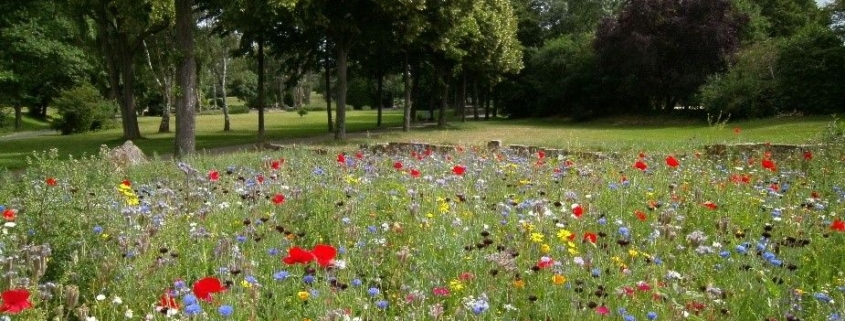
Green Gardening – Supporting Biodiversity and Conserving Water
More tips to make your green thumb a little greener!
There are so many conscious choices you can make in your garden to have a positive impact that we’ve made multiple Tool Kit posts on the subject of eco-friendly gardening! In this one we focus on how you can support pollinators, water efficiently, and embrace our local conditions for less net impact.
Opt for Native Plants
Choosing plants that are native to your region can help reduce your need for fertilizers, pesticides, and watering. Native plants are adapted for our climate and soil, and therefore require less input of nutrients and are suited for our wet winters and dry summers. They also support our local biodiversity by ensuring critters, including native birds and insect pollinators, have access to the plants they have evolved with and depend on.

When planning where and what native species to plant in your garden, consider the light and water conditions of the spot and select accordingly for the best chance for successful establishment and long-term low maintenance. Experts at nurseries can help you identify the perfect plant and how to care for it as it becomes established. Our Planting a Native Garden Tool Kit has a map of nurseries that specialize in native species.
Water Efficiently
When it comes to watering your garden, it is important to be mindful of water usage, while maintaining plant health. Here are some ways to improve the efficiency of your watering routine.
- Timing is everything. When the sun is out, water will evaporate quickly. Water your garden in the early morning or later in the evening to minimize evaporation.
- Mulching also helps prevent evaporation, instead retaining moisture where it is easily available to your plants.
- Harvest rain water and use it to water your garden. This also reduces stormwater runoff, win-win!
- Plan the layout of your garden. Be mindful of what sections of the garden are shady/sunny, and plant appropriately. Some plants love direct sunlight, whereas others prefer partial sun.
- Plant drought tolerant natives or ornamental plants like Rocky Mountain juniper, Euphorbia, Echinacea, and Yarrow.

- Water the roots, not the leaves. Drip irrigation systems can help you deliver the water exactly where you want it to go, and in the right amount in comparison to a traditional sprinkler system. Not only does this provide hydration efficiently, but by not soaking the entire plant, it causes less disease. A slow release of water also allows the soil to soak up water better, preventing runoff from the soil surface.
Check you this video from the Capital Regional District on how to install different irrigation systems:
Go for Summer Gold!
If you have a lawn, let it go gold in the summer! In our climate of warm dry summers, maintaining a green summer lawn requires a huge input of water, just when we should be adhering to watering restrictions. With climate change and increasing demands on our water supply – it is ever more important to conserve. Letting your lawn dry out is a great way to cut back on water usage.

Did you know that grass naturally hibernates during the summer? There is no harm in letting your lawn turn golden for the summer months, you are working with the natural cycle of your lawn, and you will see it bounce back with the fall rains! So, let your grass have a rest over the summer and save water and you’ll also save your self mowing in the summer heat! Check out this info sheet from the Capital Regional District for more Water Wise Lawn Care.
Support Pollinators with a Meadow Lawn
You may have heard of the slogan ‘No-Mow May’, but this pledge to stop mowing your lawn for the summer is an oversimplified solution and may cause more harm than good, as this article from Rewilding explains. In BC, non-native plant species are abundant, and the chances are that if you leave your lawn to grow over a few weeks, all that will come up will be non-native weedy species like dandelions and white clover. While you may notice that some bees do visit these flowers, they are not the best food sources for native pollinators. Did you know that dandelion pollen is actually a protein deficient food source, and can lead colonies of bees to feed on their own eggs to supplement their diets? Native flower pollen, on the other hand, offers balanced nutrients to sustain native pollinators, since the plants and pollinators would have evolved in the local ecosystem together. While the No-Mow May movement encourages the notion that messy lawns, rather than curated golf greens, are beautiful, we need to take this a step further to ensure that we are supporting our native pollinators. Rather, consider converting your lawn to a meadow!

Instead of a stark golf course lawn, why not use the space to support pollinators, fix nitrogen, manage runoff, and maintain diversity? West Coast Seeds offers different seed blends that you can try as a lawn alternative, including clovers, tall fescue, and even beautiful wildflowers. Watch your lawn space come alive with colour, texture and native bees and butterflies! Check out our Native Plants Tool Kit to learn more, and visit Satinflower Nurseries for more info about meadow-making.
Bonus Fun Tip!

Solar lights
Your green garden can be bright and event-worthy, without adding to your energy bill! There are lots of options for solar powered lights to brighten up your patio space in the evening.
Photo credits: Mina-Marie Michell on Pexels; .Daniel Johnson on Pexels; Devolk on Pixabay.
